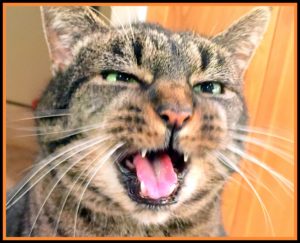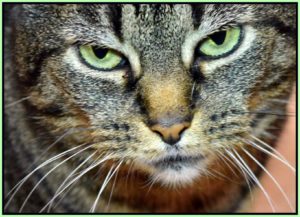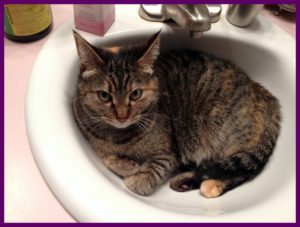Here are some feline fun facts. *Statistically, cat lovers have higher IQ’s
 than dog owners. Yes, it’s true! Really.
than dog owners. Yes, it’s true! Really.
Two university studies — Carroll University in Wisconsin and Bristol University in the UK — showed a definite correlation between cat owners (vs dog owners) and higher IQ / higher intelligence. Another unofficial study indicates that cat owners are usually better lovers, too. However, dog owners won out when it came to friendliness and obedience.
Hmmmm. Good boy. Roll over.
*Cat Whisker Fact #1 — Whiskers on a cat are extremely sensitive, with an overabundance of blood vessels and nerve endings at their bases. They can help a feline negotiate an obstacle course (like the furniture in your living, or a jungle of blackberry vines) in the dark. Cat whiskers can detect the slightest of changes in air currents velocity and direction. Because they are so sensitive, don’t pull on or mess with a cats mustache or eyebrows. They will never find this endearing.
at their bases. They can help a feline negotiate an obstacle course (like the furniture in your living, or a jungle of blackberry vines) in the dark. Cat whiskers can detect the slightest of changes in air currents velocity and direction. Because they are so sensitive, don’t pull on or mess with a cats mustache or eyebrows. They will never find this endearing.
*Cat Whisker Fact #2 — Cats not only have mustache and eyebrow whiskers, smaller ones are also found on the chin and the backs of the front paws. Because cats are farsighted and have difficulty seeing things which are quite close to them, cats in the wild use their additional whiskers to know/sense the position their edible prey so that the cat finds just the right location to inflict the fatal bite. A household cat uses its whiskers to perfectly position its squeaky toy bird or catnip mouse for the kill. Bwaahaahaa . . .You will die . . . bwaahaahaa . . .
Love those little chin whiskers on Hoover.
*Cats smell better than dogs. Cats have a keen sense of smell, primarily used in communication and recognizing marked territories. Dogs have a better sense of smell primarily because they have larger noses. Not kidding. Even little dogs have bigger noses than the largest domestic cats. With bigger beaks, dogs have 3 to 4 times more smell receptors compared to cats. However, all cat lovers know felines smell better —- you know, when you put your nose into their warm fur and sniff them. 😉
*Trapping a cat is quite easy. Put out a bag, any box, or the sink you want to shave in, and wait 6 seconds.
The central portion of a cat’s tongue is covered with filiform papillae, which are tiny backward-facing barbules. You feel them when your four-legged friend licks you. These serve several purposes. Since the hooks are angled back toward the throat, the papillae aid in holding their small squirming prey in the cat’s mouth. And, they are used to scrape and remove flesh from the bones of their meal.
Cats have few taste buds, so for maximum culinary enjoyment they rely on the smell, temperature and texture of their food as well as the taste. My girls enjoy everything about seared, unbreaded chicken strips.
One more important function: The barbs on a cat’s tongue are a great aid in keeping the cat clean. Like fine bristles on a brush, these papillae help the cat remove dirt and loose fur to maintain their always-groomed look. With matted fur, the teeth assist the tongue in undoing clingy mess. The “clacking” of a cat’s teeth as it deals with a bad hair zone is an amusing sound.
I puzzle my friends when I comment that my cats are so clean I could eat off them.




 Follow
Follow